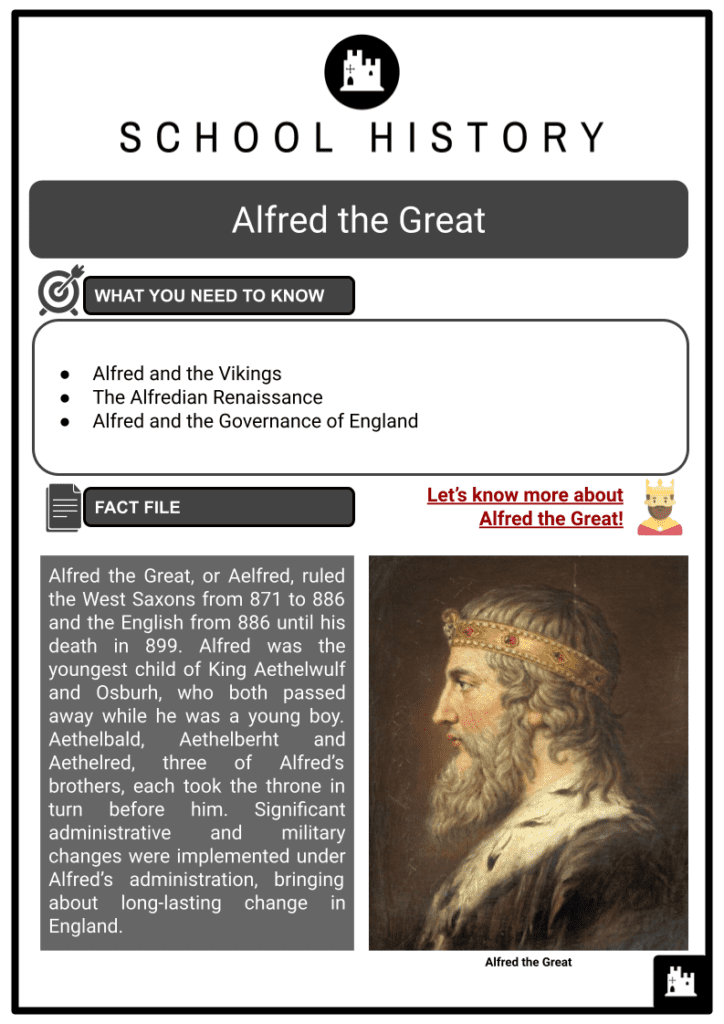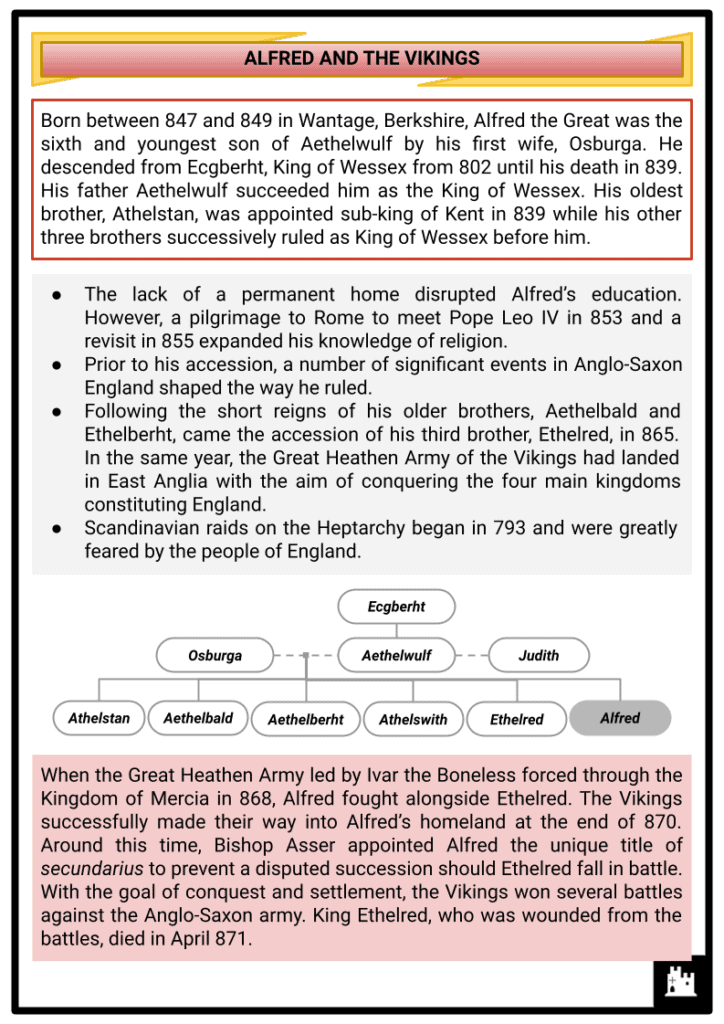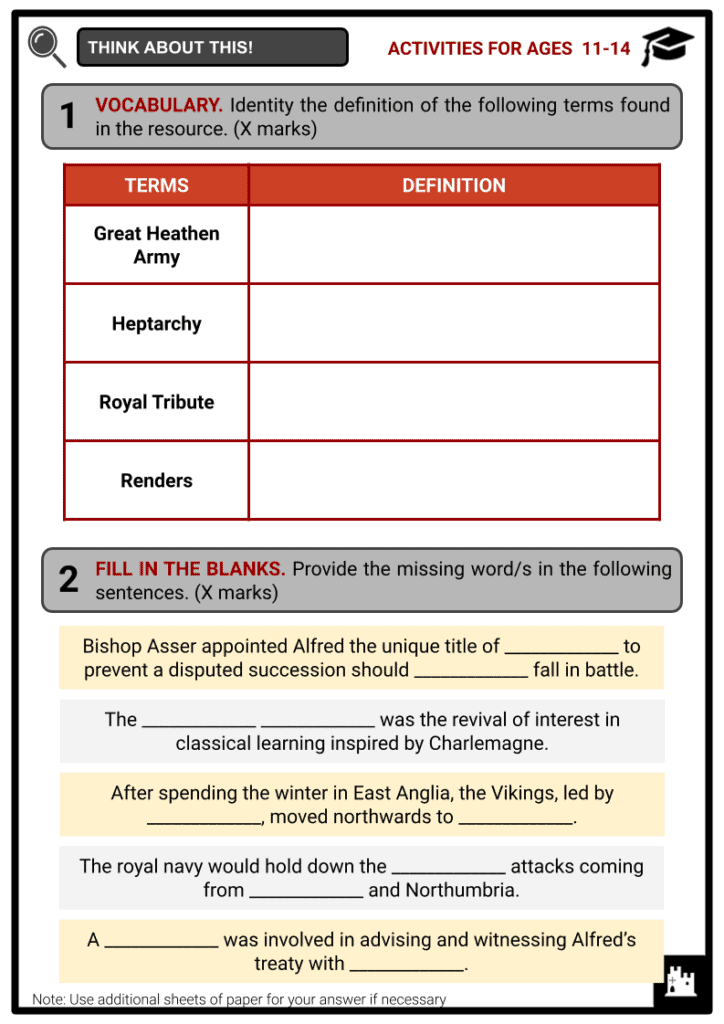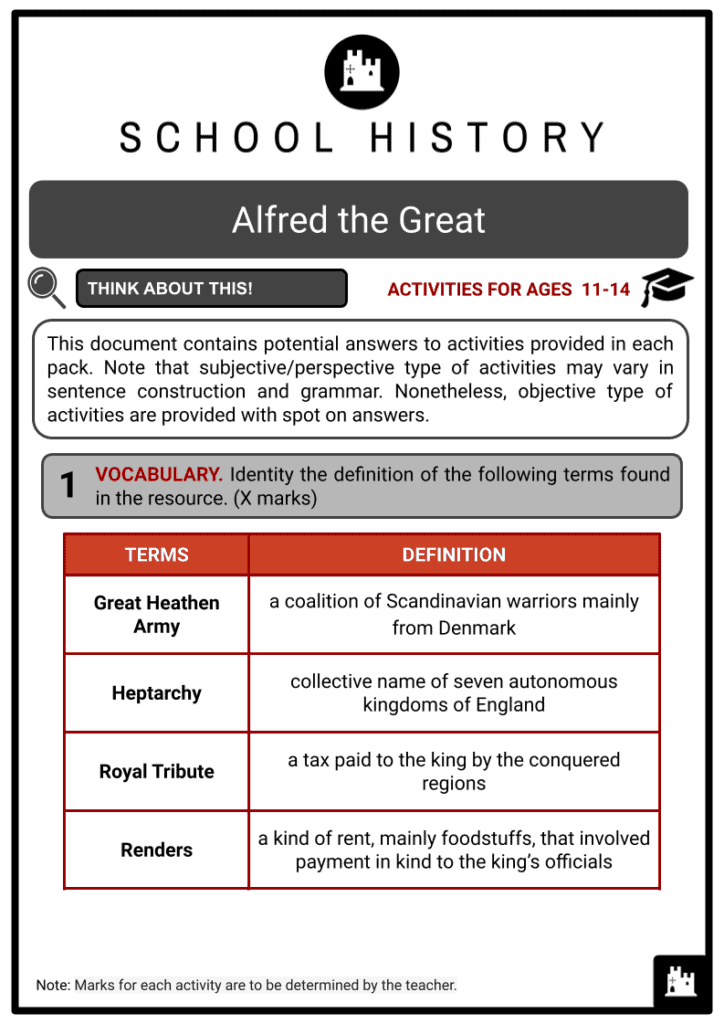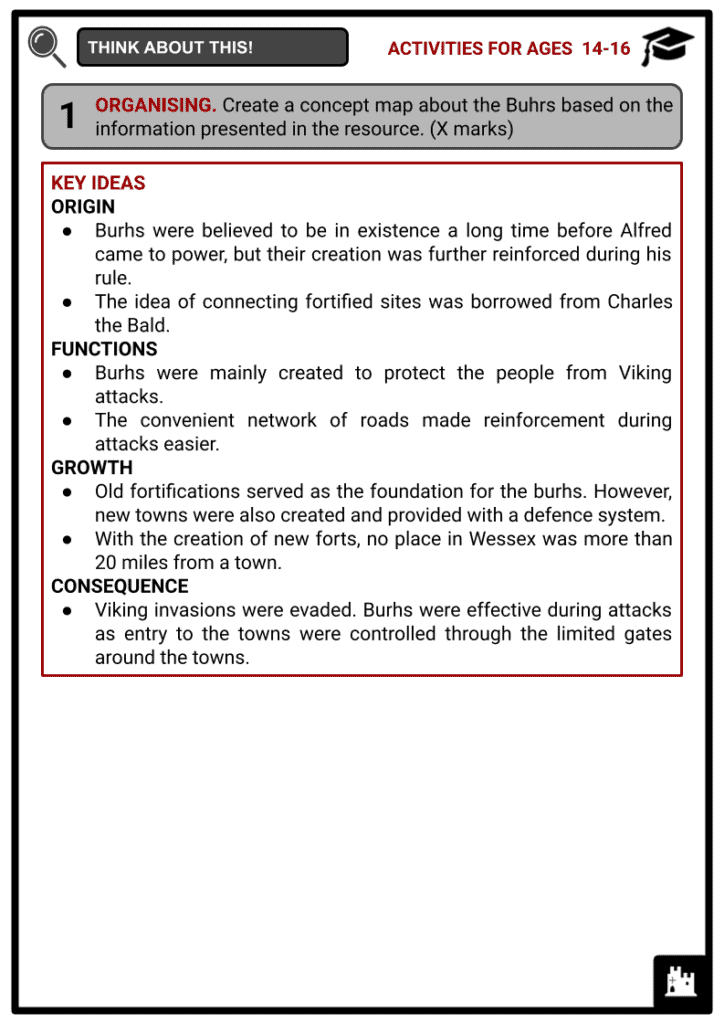Alfred the Great Worksheets
Do you want to save dozens of hours in time? Get your evenings and weekends back? Be able to teach about Alfred the Great to your students?
Our worksheet bundle includes a fact file and printable worksheets and student activities. Perfect for both the classroom and homeschooling!
Summary
- Alfred and the Vikings
- The Alfredian Renaissance
- Alfred and the Governance of England
Key Facts And Information
Let’s know more about Alfred the Great!
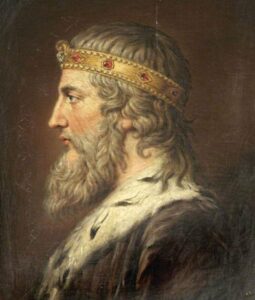
Alfred the Great, or Aelfred, ruled the West Saxons from 871 to 886 and the English from 886 until his death in 899. Alfred was the youngest child of King Aethelwulf and Osburh, who both passed away while he was a young boy. Aethelbald, Aethelberht and Aethelred, three of Alfred’s brothers, each took the throne in turn before him. Significant administrative and military changes were implemented under Alfred’s administration, bringing about long-lasting change in England.
ALFRED AND THE VIKINGS
- Born between 847 and 849 in Wantage, Berkshire, Alfred the Great was the sixth and youngest son of Aethelwulf by his first wife, Osburga. He descended from Ecgberht, King of Wessex from 802 until his death in 839. His father Aethelwulf succeeded him as the King of Wessex. His oldest brother, Athelstan, was appointed sub-king of Kent in 839 while his other three brothers successively ruled as King of Wessex before him.
- The lack of a permanent home disrupted Alfred’s education. However, a pilgrimage to Rome to meet Pope Leo IV in 853 and a revisit in 855 expanded his knowledge of religion.
- Prior to his accession, a number of significant events in Anglo-Saxon England shaped the way he ruled.
- Following the short reigns of his older brothers, Aethelbald and Ethelberht, came the accession of his third brother, Ethelred, in 865. In the same year, the Great Heathen Army of the Vikings had landed in East Anglia with the aim of conquering the four main kingdoms constituting England.
- Scandinavian raids on the Heptarchy began in 793 and were greatly feared by the people of England.
- When the Great Heathen Army led by Ivar the Boneless forced through the Kingdom of Mercia in 868, Alfred fought alongside Ethelred. The Vikings successfully made their way into Alfred’s homeland at the end of 870. Around this time, Bishop Asser appointed Alfred the unique title of secundarius to prevent a disputed succession should Ethelred fall in battle. With the goal of conquest and settlement, the Vikings won several battles against the Anglo-Saxon army. King Ethelred, who was wounded from the battles, died in April 871.
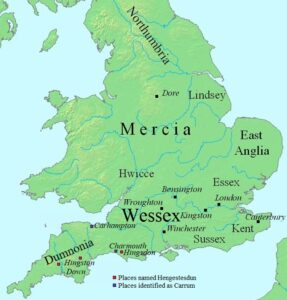
Location of Wessex - In accordance with the earlier agreement between Ethelred and Alfred, Alfred found himself thrust into the role of King of Wessex in 871. While Ethelred left two young sons, Alfred’s accession went uncontested. During the preparation for the burial ceremonies of the late king, the Anglo-Saxon army suffered another loss. Another defeat at Wilton in May made the defence of Wessex from invasion seemingly impossible. The defence of Wessex would remain one of Alfred’s concerns throughout his reign.
- The geographical breadth of the kingdom of Wessex in the 9th century was problematic with respect to defence. Alfred had to find means to defend the kingdom effectively. He organised his military forces and by 871, the Wessex soldiery consisted of the following:
- Fyrds (army) containing kinship groups throughout the land
- Fyrds belonging to separate shires led by ealdormen (men of very high rank)
- Warbands led by individual thegns (men of high rank who own vast lands)
- Upon the arrival of a large number of Scandinavian warriors in 865, King Edmund of East Anglia offered horses to the Danes as a sign of peace. Moreover, he let the invaders stay over for the winter on the Isle of Thanet. The large party of Vikings led by the three sons of Ragnar Lothbrok became known as the Great Heathen Army who began the invasion of England.
- After spending the winter in East Anglia, the Vikings, led by Ivar the Boneless, moved northwards to Northumbria. Faced with little resistance, they invaded York in November 866. The Northumbrians offered payment for the Vikings to leave. In response, Ivar and his men accepted the payment and left, but installed a puppet government to lead.
- In 867, they headed south to Mercia and captured the town of Nottingham after defeating the joint forces of Mercia and Wessex. The following year, they left Nottingham after again receiving payment from the Anglo-Saxons.
- In 869, they travelled again to East Anglia to spend the winter. However, they were met with great resistance. According to the Anglo-Saxon Chronicle, King Edmund fought against them and was defeated and killed.
- After several battles in 871, Alfred of Wessex offered payment to the Vikings in exchange for peace. The Vikings accepted and went to London for the winter.
- In the following years, the Vikings drifted between Northumbria and Mercia while the Anglo-Saxon leaders negotiated peace. By 873, the kingdom of Mercia completely fell to the Vikings.
- After eight years of raiding England, the Great Heathen Army split in half. Halfdan Ragnarsson conquered the north while the other half moved south.
- As Halfdan conquered the north, his army began to plough the land and established farms. In the south, his brother Guthrum faced a series of battles against Alfred of Wessex.
- In January 878, the Vikings attacked a royal stronghold in Wiltshire where Alfred had been staying. With a little band, Alfred fled to Somerset at Athelney and successfully mounted a resistance campaign against the Vikings. This was regarded as the lowest point in the history of the Anglo-Saxon kingdoms when most of England had fallen to the Vikings except for Wessex.
- At the Battle of Edington in May 878, Alfred and his warband, which came from Somerset, Wiltshire and Hampshire, successfully defended Wessex from the Great Heathen Army led by Guthrum. This resulted in a treaty between the two parties later the same year and the Christian baptism of Guthrum. Throughout his reign that was plagued by Viking invasions, Alfred made peace with the invaders in different ways and on various occasions.
- Most commonly, battles preceded peace negotiations. The peace agreements made between Alfred and the Vikings were as follows:
- After the defeat at the Battle of Wilton in 871, Alfred paid off the Vikings to leave his kingdom. The Vikings left and targeted the other kingdoms. This could potentially cause a rift between the kingdoms. With this treaty, Alfred had time to regroup and plan for future Viking invasions.
- In 876, as Guthrum gained a foothold in Wareham, Alfred agreed to exchange hostages and pay a significant amount of riches for the invaders to leave, but only after the Vikings swore oaths to their gods. Guthrum left Wareham but set up winter camp at Exeter.
- Guthrum reached Exeter safely but his sea fleet was destroyed by a storm. Alfred marched to Exeter and negotiated again with Guthrum in 877. This time, Guthrum held up his end of the bargain and moved to Mercia.
- Again, Guthrum broke the previous agreement and settled at Chippenham in 878. After Alfred’s victory at Edington and with the Vikings stuck in a hopeless situation, Guthrum and some prominent Vikings had to undertake a Christian baptism in accordance with the peace terms set by the Anglo-Saxons. This was followed by gift giving and feasting. Guthrum left Wessex and turned his gaze to East Anglia.
- In 885, a group of Vikings from Francia attacked Rochester. Alfred’s forces initially succeeded in fending off the invaders but were weakened when the Vikings gained support from Guthrum’s army. As a result, Alfred had to reconsider negotiations with the invaders.
- In 886, Alfred occupied London, which had traditionally been a Mercian town, and successfully recovered it from the Danes. It is suggested that Anglo-Saxon rule had been restored in London a few years earlier after the town suffered tremendously from several Viking settlements. This united the people of England under his rule with Alfred adopting the title King of the Anglo-Saxons. The creation of a united Wessex/Mercian realm was fortified by the submission of Aethelred, Lord of the Mercians.
- Realising the weaknesses of his military forces, Alfred employed military reforms to prepare for future Viking invasions such as the reorganisation of the army, increase of the royal navy, and establishment of forts around his kingdom.
- The fyrd was separated into two: half at home and half on service. This suggests a rotation of soldiery in defending the kingdom. Furthermore, it ensured that land was looked after and food supplies were maintained.
- Alfred commissioned the building of ships to an enlarged 60-oar design of his own. The royal navy would hold down the Viking attacks coming from East Anglia and Northumbria and would prevent the landing of fresh invaders.
- Alfred upgraded the defences of Wessex by erecting fortified burhs throughout the kingdom. A burh, or borough, was the fortified settlement of the Anglo-Saxons.
- Alfred’s reign was repeatedly attacked by the Vikings, mostly led by Guthrum. Guthrum occasionally accepted and broke the peace terms offered by the Anglo-Saxons. He eventually surrendered in 878, and this was followed by the treaty between the two rulers around 886 to 890. In 892, the Viking forces that returned to England were much stronger and experienced and were independent of Guthrum’s group.
THE ALFREDIAN RENAISSANCE
- Following the Anglo-Saxon victory at Edington in 878, Alfred the Great instituted military and administrative reforms and later began a religious and educational programme which restored Anglo-Saxon culture to a former golden age of wisdom and prosperity. This period came to be known as the Alfredian Renaissance.
- The cultural revival instigated under Alfred’s rule coincided with the Carolingian Renaissance. Alfred aimed to spread the knowledge of literacy both in Latin and the local vernacular not only within his court, but outside it as well. The Carolingian Renaissance was the revival of interest in classical learning inspired by Charlemagne in the Carolingian Empire from the late 8th century to the 9th century.
- With his literacy reforms, Alfred believed that an educated populace would aid in the defence of the kingdom.
- He believed that educating the important parts of the population was essential to the military defence akin to the fortified burhs that prevented the successful Viking invasion.
- His reforms aimed at solving the illiteracy and lack of learning that he observed in England, and spreading an understanding of how to live according to God’s principles.
- He also saw that administering the kingdom in a spiritual sense was part of his responsibility.
- Furthermore, Alfred deemed the reforms necessary for the proper execution of justice in his realm.
- It is also suggested that Alfred recognised the importance of literate administration. An educated populace would be able to read and carry out instructions given to them, as well as refer to written laws in matters relating to judicial principles and procedures. Alfred hoped that this would help the people to unite under further Viking raids.
- A necessary step to improve the literacy of the important parts of the population was the translation of several Latin works into English. Alfred translated Pope Gregory’s Pastoral Care, Boethius’ Consolation of Philosophy, St Augustine’s Soliloquies, and the first 50 Psalms of the Psalter with the assistance of the scholars in his court. Furthermore, he commissioned the translation of Gregory’s Dialogues, Orosius’ Histories against the Pagans, and Bede’s Ecclesiastical History. The main purpose of the translation of several important works was to enable the development of the intellectual character of Alfred’s kingdom.
- The translation of Gregory’s Pastoral Care served as a guide for the bishops in governing and correcting those under their guidance.
- The translation of Boethius’ Consolation of Philosophy was altered to reflect more the comforts of Christian wisdom than of philosophy.
- The translation of St Augustine’s Soliloquies was also altered to emphasise the relationship between wisdom, God and salvation.
- The translation of the first 50 Psalms of the Psalter was Alfred’s natural choice, in which he included his personal notes and explanation for each Psalm.
- The translation of Bede’s Ecclesiastical History presented a vision of stability and order to the English people that provided an ideal towards which Alfred’s court could seek.
- Alfred’s translation programme supported education in the local vernacular. This helped lay the foundations of Latin education for those destined for the ecclesiastical order and those who sought significant positions in Alfred’s kingdom. Instead of building numerous monasteries and churches, Alfred focused on the court school and the dispensation of texts in the vernacular language to aid the people in attaining a greater understanding of the scripture. Latin education remained necessary and intended for the clergymen.
ALFRED AND THE GOVERNANCE OF ENGLAND
- Apart from the reforms he brought about in the military and education, Alfred made skillful changes to the roles of those in his household and to other offices involved in the running of the kingdom. However, his government remained centralised as it had been in Wessex for centuries.
- The Witan consisted officially of the most important members of nobility within the kingdom, including the ealdormen and the clergymen. It was not a structured group as, at times, non-landed councillors were invited to join the council. The Witan assisted Alfred in cementing his control over Wessex and later, beyond its borders, and in defeating or making peace with the Viking invaders. A Witan was involved in advising and witnessing Alfred’s treaty with Guthrum.
- The Chronicle implies that all the important officials in Alfred’s court were thegns. There also came a subdivision of thegns known as the king’s thegns. The king’s thegns held certain privileges and answered only to the king. During Alfred’s reign, the role of thegns was reformed with the creation of a rotational duty system. Thegns were divided into three groups. Each group took it in turns to live in the royal court and perform duties by day and night for a month.
- Many of the roles of the clergy were directly associated with the functioning of the household but the clergy was also important in Alfred’s administrative system. The following were their roles:
- Instruct the king on all matters of a spiritual nature
- Assist the king and his immediate family in learning and reading
- Pray for the welfare of the king and his immediate family
- Deal with correspondence from landowners and dignitaries
- Eardormen were highly valued and were responsible for a number of significant duties such as raising armies from the shires during times of war, acting as the king’s military advisers, collecting the royal tribute, acting as special emissaries and messengers, enforcing the law, and ensuring the people carried out services for the king.
- While their rank was not as high as the other members of the king’s household and administrative system, the reeves had the most important role to play at a local level. Their responsibilities involved general administration of the king’s estates, monitoring of labour services, collection of renders and food rents from peasants, and keeping of law and order by making legal decisions and by acting as witnesses of accusations of wrongdoings.
- Burhs are usually referred to as a dwelling place that was fortified under the jurisdiction of a king. To begin the policy of creating burhs, Alfred restored the Roman cities and existing Iron Age hill forts. The burhs were carefully planned, fortified towns and performed a number of functions.
- Burhs were believed to be in existence a long time before Alfred came to power, but their creation was further reinforced during his rule. The idea of connecting fortified sites was borrowed from Charles the Bald.
- Burhs were mainly created to protect the people from Viking attacks. The convenient network of roads made reinforcement during attacks easier.
- Old fortifications served as the foundation for the burhs. However, new towns were also created and provided with a defence system. With the creation of new forts, no place in Wessex was more than 20 miles from a town.
- Viking invasions were evaded. Burhs were effective during attacks as entry to the towns were controlled through the limited gates around the towns.
- Apart from their defence purposes, it is also believed that burhs were designed to become centres of commerce. Trade and production of armouries and royal mints took place in the burhs. The creation of burhs impacted local economies and wealth creation during Alfred’s rule.
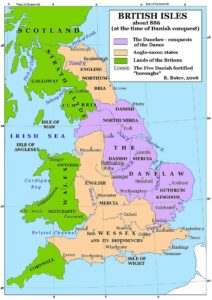
Britain in 886 - Excavations in Winchester showed a town plan which consisted of back streets running parallel to a main street with other connecting streets running at right angles to them. The proximity of living quarters to the places where goods and services could be sold and bought proved beneficial. It was an intentional feature of the Alfredian burhs. This plan enabled trade to progress. Because of this, Winchester became a centre of economic importance. Other burhs also developed as market towns, as a mint was established in numerous fortified towns.
- Around 885, Alfred began referring to himself as King of the Anglo-Saxons or King of the English. However, he never reigned over the territory of all the Anglo-Saxon kingdoms. At most, he was the ruler of the united realm of Wessex and Mercia amid the Viking threat.
- The title of King of the English may be more in reference to his lineage of the last surviving Anglo-Saxon royal house rather than a claim to rule over the whole of England. It may also refer to him being the ruler of the only province that was not conquered by foreign invaders at a time when the other Anglo-Saxon kingdoms fell under the Vikings. Furthermore, it is worth noting the consequences of Alfred’s reign to conclude whether Alfred deserved the epithet ‘the Great’.
- In the end, Alfred’s several reforms in administration, military, education and religion allowed him to pass along the title of King of the English to his successor, Edward. By the time of Alfred’s death in 899, there was a relative stability in England but much work had to be done to maintain it. Edward had to ensure the protection of the kingdom against possible future attacks by the Vikings.

